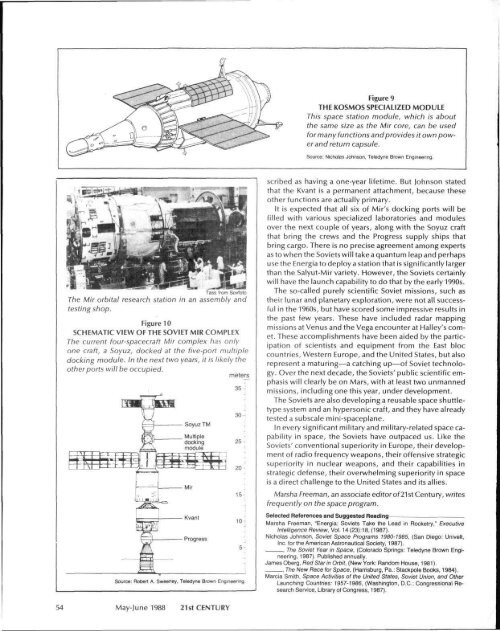The Geometry The Nucleus
The Geometry The Nucleus
The Geometry The Nucleus
Create successful ePaper yourself
Turn your PDF publications into a flip-book with our unique Google optimized e-Paper software.
Figure 9<br />
THE KOSMOS SPECIALIZED MODULE<br />
This space station module, which is about<br />
the same size as the Mir core, can be used<br />
for many functions and provides it own power<br />
and return capsule.<br />
Source: Nicholas Johnson, Teledyne Brown Engineering.<br />
<strong>The</strong> Mir orbital research station in an assembly<br />
testing shop.<br />
and<br />
Figure 10<br />
SCHEMATIC VIEW OF THE SOVIET MIR COMPLEX<br />
<strong>The</strong> current four-spacecraft Mir complex has only<br />
one craft, a Soyuz, docked at the five-port multiple<br />
docking module. In the next two years, it is likely the<br />
other ports will be occupied.<br />
meters<br />
35-<br />
scribed as having a one-year lifetime. But Johnson stated<br />
that the Kvant is a permanent attachment, because these<br />
other functions are actually primary.<br />
It is expected that all six of Mir's docking ports will be<br />
filled with various specialized laboratories and modules<br />
over the next couple of years, along with the Soyuz craft<br />
that bring the crews and the Progress supply ships that<br />
bring cargo. <strong>The</strong>re is no precise agreement among experts<br />
as to when the Soviets will take a quantum leap and perhaps<br />
use the Energia to deploy a station that is significantly larger<br />
than the Salyut-Mir variety. However, the Soviets certainly<br />
will have the launch capability to do that by the early 1990s.<br />
<strong>The</strong> so-called purely scientific Soviet missions, such as<br />
their lunar and planetary exploration, were not all successful<br />
in the 1960s, but have scored some impressive results in<br />
the past few years. <strong>The</strong>se have included radar mapping<br />
missions at Venus and the Vega encounter at Halley's comet.<br />
<strong>The</strong>se accomplishments have been aided by the participation<br />
of scientists and equipment from the East bloc<br />
countries, Western Europe, and the United States, but also<br />
represent a maturing—a catching up—of Soviet technology.<br />
Over the next decade, the Soviets' public scientific emphasis<br />
will clearly be on Mars, with at least two unmanned<br />
missions, including one this year, under development.<br />
<strong>The</strong> Soviets are also developing a reusable space shuttletype<br />
system and an hypersonic craft, and they have already<br />
tested a subscale mini-spaceplane.<br />
In every significant military and military-related space capability<br />
in space, the Soviets have outpaced us. Like the<br />
Soviets' conventional superiority in Europe, their development<br />
of radio frequency weapons, their offensive strategic<br />
superiority in nuclear weapons, and their capabilities in<br />
strategic defense, their overwhelming superiority in space<br />
is a direct challenge to the United States and its allies.<br />
Marsha Freeman, an associate editor of 21st Century, writes<br />
frequently on the space program.<br />
Selected References and Suggested Reading<br />
Marsha Freeman, "Energia: Soviets Take the Lead in Rocketry," Executive<br />
Intelligence Review, Vol. 14 (23):18, (1987).<br />
Nicholas Johnson, Sower Space Programs 1980-1985, (San Diego: Univelt,<br />
Inc. for the American Astronautical Society, 1987).<br />
, <strong>The</strong> Soviet Year in Space, (Colorado Springs: Teledyne Brown Engineering,<br />
1987). Published annually.<br />
James Oberg, Red Star in Orbit, (New York: Random House, 1981).<br />
, <strong>The</strong> New Race for Space, (Harrisburg, Pa.: Stackpole Books, 1984).<br />
Marcia Smith, Space Activities of the United States, Soviet Union, and Other<br />
Launching Countries: 7957-1986, (Washington, D.C.: Congressional Research<br />
Service, Library of Congress, 1987).<br />
54 May-June 1988 21st CENTURY

















